Bulk Orders
For making a bulk order, please email your requirements to onpery@careformlabs.com.
Customization
For bulk orders, the hardness/shore and colour of the product can be customized.
Cup's design awarded by









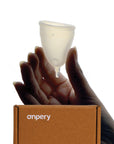
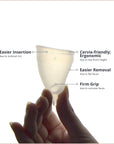
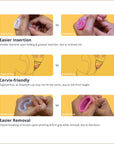

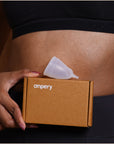
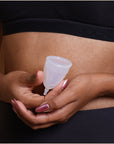
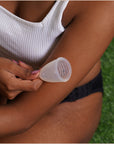
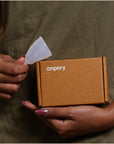
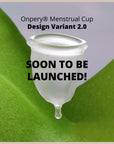
First indigenous patent-applied | ONPERY® MENSTRUAL CUP | Easier to Use, Easier to Insert, Easier to Remove, Better Grip, Ergonomic | 100% Medical Grade Silicone
S [Small]:
- Great for beginners (new adopters of an internal menstrual product); or
- Low to regular cervix height; or
- Low to regular flow.
- Height: 61 mm (incl. 12 mm of stem)
- Diameter: 39 mm
- Hardness: ~65%
L [Large]:
- Ideal for post-vaginal child delivery; or
- Regular to high cervix height; or
- Regular to high flow.
- Height: 69 mm (incl. 12 mm of stem)
- Diameter: 44 mm
- Hardness: ~65%
How to measure the cervix height?
One needs to insert their index finger into their vagina to measure their cervix. It is suggested to measure it on the first or last day of their menstruation. The cervix is supposed to feel like the tip of the nose.
100% FDA-approved medical grade silicone Class VI (Silipure Platinum Cure).
The material is free of Phthalate, Bisphenol & Volatile Plasticizer.
- ISO 10993:2018 Biocompatibility tests: Implantation, Hemolysis test, Acute toxicity, Irritation test, Skin Sensitization, Pyrogenicity, Cytotoxicity & Genotoxicity.
- Product manufactured in a FDA-approved clean-lab facility.
- ISO 13485:2016: Design, manufacturing and dispatch of extruded and moulded silicone and FKM rubber products in different shapes and sizes used in medical industries.
- ISO 45001:2018, ISO 14001:2015 & ISO 9001:2015: The management system is applicable to medical devices.
- Declarations: RoHS, WEE, Heavy Metal, REACH & TBE/BSE.
- Products can be reused for up to 5 years, depending on the usage.
- 1 unit of the product may replace about ~780 disposable generic sanitary napkins.
Bought together
Internal Menstrual Products
Value
Novel Design
Lifestyle Value
Maintenance
First-time adopters:
- It is suggested that one should relax before trying out the cup. Maybe taking a few deep breaths, as this exercise helps the vaginal muscles to relax. The cup should not be tried/ used in a tense state of mind.
- The vagina should be lubricated when one uses the cup. Users can try using water to make the process smooth and irritation-free.
The journey can be daunting for a first-time user, but if one tries consistently, one’ll be comfortable with the product in about two menstrual cycles. Prior cup users will find it much easier to switch to Onpery® menstrual cups within the first cycle.
Leakage:
- When one is switching to a menstrual cup (for the first-time or to a different brand/ design), it is suggested to use it along with a liner or napkin, for the first few menstrual cycles.
- To make sure that the cup has popped-up & formed the seal (air-tight suction) at the vaginal wall after insertion, one should gently twist or rotate the cup from the bottom. Further one should gently try to pull the cup and if the cup is not coming out or sliding, then it can be understood that it has formed the seal (air-tight suction).
Maintaining product lifecycle:
- Vapours should not be left on the cup after sterilization. Vapours have to be wiped with a cotton cloth.
- Cup has to be stored in a dry and dark (no sunlight) space.
- Cup has to be kept away from hot surfaces.
- Any scratches or cuts on the cup have to be avoided.
- Not to be used by menstruators using Copper-IUD.
- Not to be used post-delivery of infant(s), for about a year. One may consult a doctor in such cases.
A user can dump the product into a medical waste bin near a medical clinic or similar place from where the menstrual cup can be treated as medical waste (such as it may go into an incinerator and getting converted into ash).
One can also burn the silicone menstrual cup to ash. Medical-grade silicone is derived from silica, which is found in sand. Silicone is made through a chemical process but from natural materials, so the ash left behind isn’t harmful to the environment.
How to know if the Cup is not ideal for use anymore:
- If there is any scratch or cut on the surface of the cup.
- If the cup has deformed due to coming in contact with a hot surface.
Discolouration:
The silicone (if 100% pure) by nature changes its colour if kept in an open space. If the Onpery® menstrual cup changes its colour after a few months due to natural reasons, then there is nothing to be worried about. In case of any concern please contact a doctor.
How to Use
FAQ
One-word answer is - No.
A "virgin" is considered to be someone who's never had sex. Sexual engagement is a wide spectrum and it depends on what is considered to be intercourse. It is widely considered that having penis-in-vagina sex for the first time is how one "loses their virginity" (as the hymen gets broken and the blood is released).
But speaking biologically, the hymen is a thin piece of tissue that fully or partially covers the vagina; insertion/ removal of the cup may break the hymen (which may release blood), but so can activities like playing sports or cycling. In fact, there are some people who are born without a hymen.
Hence, using a cup has nothing to do with "virginity".
No! The cup is placed in the vagina, after being inserted from the outer opening of it at the vulva. The vagina is usually up to 60 mm long. The other side of it has a cervix which has a very tiny hole through which it is impossible for the cup to pass. Hence, the cup has only one side to enter and the same side to exit from the vagina, and so the cup will never get lost.
If a cup is causing discomfort, chances are that it is hitting the wall/ bottom of the cervix, because the cup not being of appropriate size.
If one uses the appropriate size of the cup and still feels some discomfort, then they should consult a doctor.
Vulva has two openings, one is of the vagina and another is called the urethra, from where urine escapes the body. As the cup is in the vagina and not the urethra (which anyway is not possible to be in), the cup cannot block or collect urine. Hence, one doesn’t need to remove their cup while peeing.
The vagina is a wonderful organ and one can compare it to a rubber band. It will slightly spread when the cup is placed but it will come back to its original position and form once the cup is removed. Using a menstrual cup will not affect the size or form of the vagina.
If one is using a certified and medical-grade silicone menstrual cup, and maintained it properly, then there will be no possibility of any infections from the material, as silicone doesn’t react with the human body.
A simple way of tackling this in the initial days is to set a timer. The nature of menstrual cycles varies from person to person, and for the first few usages, one can remove and reinsert the cup frequently to get an idea of the flow and usage duration. A cup can normally be used anywhere between 6 to 10 hours on a stretch.
It is recommended to replace a menstrual cup every 3-5 years. It should be replaced immediately if it has any cuts, holes, scratches, deformation or just isn’t simply in a good condition anymore.
Silicone changing its colour (mostly yellowish) with time is a natural property of the material and is not a cause for concern.
One can switch to a cup at any age provided they find their suitable cup size. Women who are using Copper-IUD or have given birth in the last 12 months should not use the cup.
Cup Vs Disc
- Cup is placed at the lower side of the vagina, but the disc is placed at the vaginal fornix (higher side of the vagina or just below the cervix).
- Disc can be used by menstruators who are already using Copper-IUD, as Disc doesn't form a seal (air-tight suction) with the vaginal wall whereas Cup does forms a seal (air-tight suction). If a menstruator using Copper-IUD, doesn't properly break the air-tight suction of the cup while pulling the cup out, then the Copper-IUD can get displaced and/or can pinch the uterus.
- Disc can be used by menstruators for mess-free penetration while being on menstruation, including sexual intercourse. Also, this may reduce menstrual cramps in certain cases.
